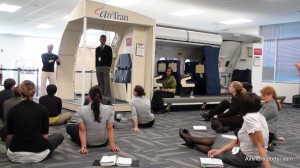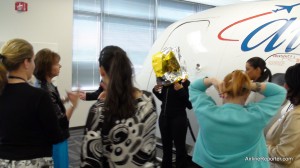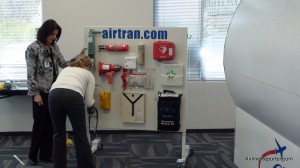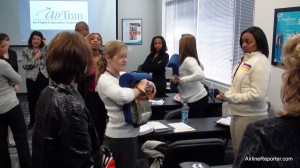
Class of new flight attendants learning how to open and close the main cabin door.
Every time you board an airline you are greeted (at least should be) by a friendly flight attendant. You will also see them serving you drinks, snacks and, if you are lucky, a meal. However, their job is so much more important than the things you see on an average flight. I think each of us frequent fliers feels as though we have a good idea of what a flight attendant’s job duties are. However, I wanted to see what they are taught first hand.
Recently, given the opportunity to see AirTran flight attendants train, I flew down to their flight attendant training program in Atlanta, GA in order to hang out for two days and get to see some of the training each of their flight attendants receive. I was surprised how much I learned in the two days I was down there.
During my visit I was able to see and experience the two main aspects of a flight attendant’s job: taking care of the customers and safety. Luckily airline accidents are rare and most people don’t have to see a flight attendant’s safety training in action, but that training is extremely important.

Current flight attendants putting on full head gear to use while putting out a fire.
There were two classes that I kept bouncing back and forth between. One was a group of new hires (I shall call them “the newbies“) who were about two weeks into their four week training and the other group was current flight attendants (I shall call them “the pros“) who were training just for one day.
The newbies were mostly going through customer service and in-flight service training whereas the pros were practicing different safety procedures. Seeing both sides really let me know how important both aspects are to being a great flight attendant.
Hopefully most people will never have to witness a flight attendant’s safety training kick in, but it could help to save your life someday. During the time I was following the pros around I witnessed them practice putting out fires and providing first aid. They have to know which type of extinguisher to use on specific types of fires, how to make the extinguisher work, when to put on the full head gear and how to properly put out a fire. This stuff is much more complex than just pouring a cup of coffee.

Practicing how to use all the safety equipment and hoping they won't ever have to use it.
While hanging out with the newbies, watching them learn where safety items are located on an aircraft, I asked on Twitter, “Anyone guess the 5 things checked by #AirTranFA [flight attendants] in the [lavatory] during preflight?”
Most people responded with things like, “check the soap level,” or “make sure it is clean.” Although, yes that might be part of their job, no one really answered any safety related questions. Here are the five things they have to check:
1) Make sure the smoke detector is operating.
2) Check the trash lid to make sure it automatically closes. This is because passengers will try to smoke in the lavatories (big no-no) and put their cigarettes out in the trash, which can catch fire.
3) Make sure the fire suppressant system for the trash is full (a bit off topic: I heard a story that some passengers will hover over the toilet and blow smoke down the drain to avoid being detected).
4) Look to see that the “No Smoking” place cards are still there.
5) Make sure the ashtray is functioning. This might seem silly for why there is an ashtray, but in reality passengers will try to smoke on flights and if they do and the alarm goes off, they want them to properly dispose of the cigarette instead of putting it in the trash and possibly starting a fire.

Practicing to make your seat cushion your best friend.
The five items to check in the lavatory are just one example of the many things that flight attendants do, that passengers have no idea about.
Yes, they are going to make sure the bathroom is ready for you to use, but they also make sure it will be a safe flight.
Back in the day, flight attendants had to be nurses. In case something happened mid-flight, they could then assist the passengers. Even though being a nurse is no longer a requirement, they must still be trained in proper CPR procedures. In most cases there will be a trained nurse or doctor on a flight that will be able to assist a passenger in trouble, but if not, flight attendants are trained to keep a sick passenger alive until the flight can land.
Another part of training that the pros went through, was practicing how to handle a plane ditching into the water. Tomorrow I will post about this experience. I don’t want to ruin it, but it involves darkness, smoke, and screaming.
A Day In The Life Of…A Training Flight Attendant
PART 1 | PART 2 | PART 3 | PART 4 | PART 5 | ALL | PHOTOS
connect | web | twitter | facebook |
Wow, I had no idea they used to have to be nurses.
I also had no idea they used to have to be nurses! This makes sense to me of course because my ex-boyfriend received excellent “medical care” in-flight… I used to work for an airline and my boyfriend and I flew to Vegas for NYE – no hotel room, just fly in at 11pm, out at 5am. Needless to say, he was feeling “rough” on the flight back to SEA. At one point I hear this loud “THUD” somewhere behind me only to realize he had fainted in the aisle. A very kind (and nonplussed) flight attendant escorted him back to his seat and set him up with oxygen – not only did the jerk get all kinds of attention, but his hangover was cured!
My favorite reality show of all time is still the Flight Attendant School that followed the training at Frontier Airlines.
I can’t wait to read about the darkness, smoke, and screaming tomorrow!
I have heard about this, but have not seen it yet. I will have to take a look!
David
I recently flew with Southwest and the flight attendant cracked jokes the whole time he was describing safety features… I thought it was pretty entertaining but wondered if I would have seen the humor in it had it been my first flight. If I hadn’t had the schpeel memorized, I might have been in a complete panic…! Then again, maybe not.
Aren’t flight attendants instructed how to read the instructions by book (such as an arresting officer would with Miranda rights)?? Curious…
Hey Laura!
You make a really good point. There are a lot of people in the industry that don’t like how Southwest does their safety announcements. Yes, it gives a fun atmosphere, but some feel it should be taken more seriously.
I always wonder, when they make it more fun do more people pay attention? Or do people feel it is less important?
David
Laura makes an excellent point. Safety Briefs are scripted and should normally be delivered in a way that is compliant with company cabin crew safety manuals – and deviating from the ‘approved’ patter could possibly even be considered non-compliant. Airlines could potentially face litigious consequences if it were proven that the safety brief wasn’t delivered ‘by the book’. Humor has its place on an aircraft, but I often feel that the entertaining aspect detracts from the serious safety message.
It’s good to see you writing about this topic. Even though I’m flight crew, I still listen to cabin crew briefs, still check my exits and do everything they ask; and I’m amazed how many ‘so-called’ frequent flyers choose to ignore the efforts of cabin crew. Flight crew brief a departure from an airport they’ve departed from a thousand times like it’s their first for good reason. Passengers should really feel the same way about their own safety.
It’s sad that some people only treat cabin crew with the respect they deserve when they’re called upon to play their part in an incident.
Hey Marty!
Thanks for your comment. A lot of the FA’s in Atlanta said they have noticed a lot more passengers seem to be paying attention after the whole Hudson US Airways flight. Have you noticed that as well?
David
Hi David. As flight crew, I rarely see enough of passenger reactions to make any comment there – although I can only assume that there’s more awareness now than there once was.
When I do pax, I do see a lot of people listening to iPods, reading and doing everything other than paying attention. The Aussie experience is a little different to the USA, and I don’t think Hudson really impacted on ‘our’ guests the same way it did yours. Had an A320 pranged into Sydney Harbour, I’m sure we would elicit attention from a broader group.
When I’m in uniform flying home, I make a huge effort to study the safety card and I listen and watch the safety demo like it’s the first time I’ve ever seen it – setting some kind of example. If nothing else, it usually makes the person I’m sitting next to do the same 🙂
All that aside, I think it’s just rude not to listen.
Heh, I had the blog set up only to allow 5 comments deep (I couldn’t reply to you), good thing I have access to change that :).
That is good. I think it sets a good example too. “Dang, that guy is a pilot and he is still reading the safety information card.”
I like to look at them to make fun of the funny faces people have! I always check where my exits are too and after the experiencing the practice ditch landing (my post today) it has put a new perspective for me on safety.
David
To me…any flight attendant who makes the safety announcement into a standup comedy routine is not taking their job seriously enough.
It’s not just humor. There’s a stack of Southwest (and other) flight attendant videos that the companies seems to embrace in the interests of viral exposure – perhaps at the expense of the message – although they do seem to make people listen. Then there’s the NZ “Nothing to Hide” safety demonstration that delivers the unadulterated patter (even if you can’t understand the Kiwi accent) – but they present it in body paint. AirNZ probably found a healthy balance.
My own airline’s cabin crew used to engage in the typical and cliche comedy routine until it was realised how sick people were of hearing the same jokes over and over – notwithstanding the legality of vacating from an approved safety brief script.
Chis J, when you say that cabin crew who consider themselves comedians don’t take their job seriously, I’m not entirely sure I agree… I think that they think they’re doing the right thing. Perhaps they are? Despite the fact that I think they’re a joke, I think I’m in the minority.
David, what is the AirTran view on cabin crew comedy?
I am not sure what AirTran’s official stance on it, but talking with some of the trainers and current flight attendants, they seemed pretty set on making sure that FA’s take the safety announcement very seriously. But also saying to make sure to take the time and interact with some passengers to build a rapport, but when talking about safety is not the time to do it.
I know therenare videos of air tran flight attendant training on YouTube from other stuff. Has yours been posted? I would love to seenit.
I HAVE BEEN IN AIRPLANE